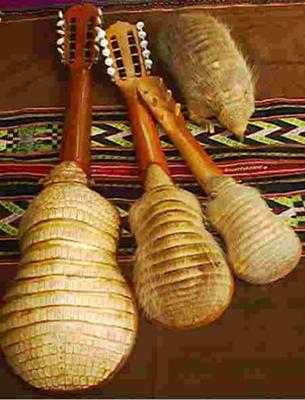A Musical Instrument Made from Something Fuzzy.
by Kricket
(BoliviaBella.com)
Welcome back to the Bolivia for Kids blog. Today's fact of the week is rather peculiar. We all know what a guitar is right? Well there is a certain type of guitar that is made from the back of an armadillo! It's called:
The Charango
Though it looks like a guitar, it is an Andean instrument from the lute family. It was first made in Quechua and Aymara tribes during the post-Colombian times. After America found the instrument, it managed to stay in Ecuador, Bolivia, Peru, the northern part of Chile and the northwest of Argentina. Here it is a popular musical instrument. This young charango player is amazing!
About 66cm long, it is traditionally made using the shell of an armadillo, but it is also sometimes made of wood which has been found to be a better resonator (that means it sounds better). That's why wood is often used in everyday instruments. On top of that, a certain one is made out of calabash (a type of gourd) for children.
Many charangos are made of different types of woods. Usually it has 10 strings in five sets of double strings, although other types exist. It normally is played in traditional Andean music by a charanguista (charango player), however it can be used in other South American music. The charango's pitch is a lot higher than the a guitar! Watch this video to hear how beautiful the charango sounds:
Something I found was that if you look at it from the top, it seems like a regular guitar, only tinier. It's at the back where you find the hairy armadillo shell. Charangos are made by people who specialize in making string instruments. They are called "luthiers". Bolivia has many really talented luthiers.
And that is the Charango, the instrument made of armadillo shell. Take a look at a household instrument you have. Can you find out anything about it that's cooler than this? Answer in the comments. Bye!
The Charango
Though it looks like a guitar, it is an Andean instrument from the lute family. It was first made in Quechua and Aymara tribes during the post-Colombian times. After America found the instrument, it managed to stay in Ecuador, Bolivia, Peru, the northern part of Chile and the northwest of Argentina. Here it is a popular musical instrument. This young charango player is amazing!
About 66cm long, it is traditionally made using the shell of an armadillo, but it is also sometimes made of wood which has been found to be a better resonator (that means it sounds better). That's why wood is often used in everyday instruments. On top of that, a certain one is made out of calabash (a type of gourd) for children.
Many charangos are made of different types of woods. Usually it has 10 strings in five sets of double strings, although other types exist. It normally is played in traditional Andean music by a charanguista (charango player), however it can be used in other South American music. The charango's pitch is a lot higher than the a guitar! Watch this video to hear how beautiful the charango sounds:
Something I found was that if you look at it from the top, it seems like a regular guitar, only tinier. It's at the back where you find the hairy armadillo shell. Charangos are made by people who specialize in making string instruments. They are called "luthiers". Bolivia has many really talented luthiers.
And that is the Charango, the instrument made of armadillo shell. Take a look at a household instrument you have. Can you find out anything about it that's cooler than this? Answer in the comments. Bye!
Sources:
https://youtu.be/bQfzYSj6Ypg
https://youtu.be/_pb-UWkRiMI
Submitted 2015-3-24

